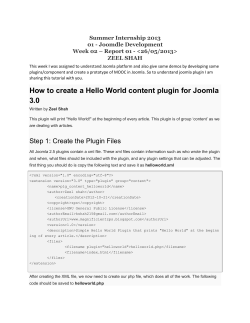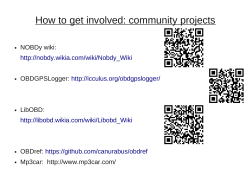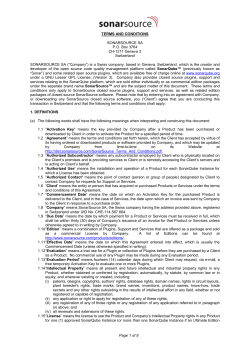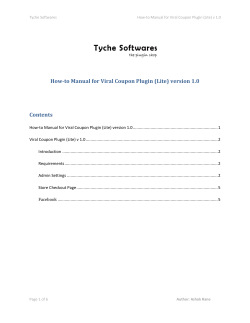
Joomla! Developer - How to Create a Joomla! Plugin
Joomla! Developer - How to Create a Joomla! Plugin
1 of 6
http://developer.joomla.org/tutorials/184-how-to-create-a-joomla-plugi...
How to Create a Joomla! Plugin
Written by Andrew Eddie
Introduction
Joomla! plugins serve a variety of purposes. As modules enhance the presentation of the final output of the
Web site, plugins enhance the data and can also provide additional, installable functionality.
This tutorial looks at the general principles used to design and build a plugin.
Plugin Types
While the number of possible types of plugins is almost limitless, there are a
number of core plugin types that are used by Joomla!. These core types are
grouped into directories under /plugins/. They are:
authentication
content
editors
editors-xtd
search
system
user
xmlrpc
Authentication plugins allow you to authenticate (to allow you to login) against
different sources. By default you will authenticate against the Joomla! user
database when you try to login. However, there are other methods available
such as by OpenID, by a Google account, LDAP, and many others. Wherever a
source has a public API, you can write an authentication plugin to verify the
login credentials against this source. For example, you could write a plugin to
authenticate against Twitter accounts because they have a public API.
Content plugins modify and add features to displayed content. For example,
content plugins can cloak email address or can convert URL's into SEF format.
Content plugins can also look for markers in content and replace them with
other text or HTML. For example, the Load Module plugin will take {*loadmodule banner1*} (you would
remove the *'s in practice. They are included to actually prevent the plugin from working in this article), load
all the modules in the banner1 position and replace the marker with that output.
Editor plugins allow you to add new content editors (usually WYSIYWG).
Editor-XTD (extended) plugins allow you to add additional buttons to the editors. For example, the Image,
Pagebreak and Read more buttons below the default editor are actually plugins.
Search plugins allow you to search different content from different components. For example, search plugins
for Articles, Contacts and Weblinks are already provided in Joomla!.
System plugins allow you to perform actions at various points in the execution of the PHP code that runs a
Joomla! Web site.
User plugins allow you to perform actions at different times with respect to users. Such times include logging
in and out and also saving a user. User plugins are typically user to "bridge" between web applications (such as
creating a Joomla! to phpBB bridge).
XML-RPC plugins allow you to provide additional XML-RPC web services for your site. When your Web
8/28/2008 8:34 AM
Joomla! Developer - How to Create a Joomla! Plugin
2 of 6
http://developer.joomla.org/tutorials/184-how-to-create-a-joomla-plugi...
site exposes web services, it gives you the ability to interact remotely, possibly from a desktop application.
Web services are a fairly advanced topic and will not be covered in much detail here.
The Basic Files
While a plugin can have any number of files, there are two you need as a minimum and there are specific
naming conventions you must follow. Before we look at the files, we must decide what sort of plugin we are
going to create. It must either fall under one of the built-in types (authentication, content, editors, editors-xtd,
search, system, user or xmlrpc) or your can create your own type by adding a new folder under /plugins/.
So, files for an authentication plugin will be saved under /plugins/authentication/, files for a system
plugin will be saved under /plugins/system/, and so on.
Let's look at an example creating the basic skeleton for a system plugin called "Test". There is no restriction
on the file name for the plugin (although we recommend sticking with alpha-numeric characters and
underscores only), but once you decide on the file name, it will set the naming convention for other parts of the
plugin.
For this plugin you will need to create a PHP file, test.php, which is the file actually loaded by Joomla! and
an XML file, text.xml, which contains meta and installation information for the plugin as well as the definition
of the plugin parameters.
test.php
The skeleton test.php has the following source:
<?php
// no direct access
defined( '_JEXEC' ) or die( 'Restricted access' );
jimport( 'joomla.plugin.plugin' );
/**
* Example system plugin
*/
class plgSystemTest extends JPlugin
{
/**
* Constructor
*
* For php4 compatibility we must not use the __constructor as a constructor for plug
* because func_get_args ( void ) returns a copy of all passed arguments NOT referenc
* This causes problems with cross-referencing necessary for the observer design patt
*
* @access
protected
* @param
object $subject The object to observe
* @param
array
$config An array that holds the plugin configuration
* @since
1.0
*/
function plgSystemTest( &$subject, $config )
{
parent::__construct( $subject, $config );
// Do some extra initialisation in this constructor if required
}
/**
* Do something onAfterInitialise
*/
function onAfterInitialise()
{
// Perform some action
}
}
Let's look at this file in detail. Please note that the usual Docblock (the comment block you normally see at the
8/28/2008 8:34 AM
Joomla! Developer - How to Create a Joomla! Plugin
3 of 6
http://developer.joomla.org/tutorials/184-how-to-create-a-joomla-plugi...
top of most PHP files) has been omitted for clarity.
The file starts with the normal check for defined( '_JEXEC' ) which ensures that the file will fail to execute
if access directly via the URL. This is a very important security feature and the line must be placed before any
other executable PHP in the file (it's fine to go after all the initial comment though). The importance of having
this check your PHP files cannot be overemphasised.
Next we use the jimport function to load the library file with the definition of the JPlugin class.
You will notice that a plugin is simply a class derived from JPlugin (this differs from previous versions of
Joomla!). The naming convention of this class is very important. The formula for this name is:
plg + Proper case name of the plugin directory + Proper case name of the plugin file
without the extension.
Proper case simply means that we capitalise the first letter of the name. When we join them altogether it's then
referred to as "Camel Case". The case is not that important as PHP classes are not case-sensitive but it's the
convention Joomla! uses and generally makes the code a little more readable.
For our test system plugin, the formula gives us a class name of:
plg + System + Test = plgSystemTest
Let's move on to the methods in the class.
The first method, which is called the constructor, is completely optional. You only require this is you want to
do some work when the plugin is actually loaded by Joomla!. This happens with a call to the helper method
JPluginHelper::importPlugin( <plugin_type> ). This means that you even if the plugin is never
triggered, for whatever reason, you still have an opportunity to execute code if you need to in the constructor.
In PHP 4 the name of the constructor method is the same as the name of the class. If you were designing only
for PHP 5 you could replace this with the name of __constructor instead.
The remaining methods will take on the name of "events" that are trigger throughout the execution of the
Joomla! code. In the example, we know there is an event called onAfterInitialise which is the first event
called after the Joomla! application sets itself up for work. For more information on when some events are
triggered, see the API Execution Order page on the Documentation Wiki.
The naming rule here is simple: the name of the method must be the same as the event on which you want it
triggered. The Joomla! Framework will auto-register all the methods in the class for you.
That's the basics of the plugin PHP file. It's location, name and methods will depend on what you want to use
the plugin for. One thing to note about system plugins is that they are not limited to handling just system
events. Because the system plugins are always loaded on each run of the Joomla! PHP, you can include any
triggered event in a system plugin.
The events triggered in Joomla! are:
Authentication
onAuthenticate
Content
onPrepareContent
onAfterDisplayTitle
onBeforeDisplayContent
onBeforeContentSave (new in 1.5.4)
onAfterContentSave (new in 1.5.4)
8/28/2008 8:34 AM
Joomla! Developer - How to Create a Joomla! Plugin
4 of 6
http://developer.joomla.org/tutorials/184-how-to-create-a-joomla-plugi...
Editors
onInit
onGetContent
onSetContent
onSave
onDisplay
onGetInsertMethod
Editors XTD (Extended)
onDisplay
Seach
onSearch
onSearchAreas
System
onAfterInitialise
onAfterRoute
onAfterDispatch
onAfterRender
User
onLoginUser
onLoginFailure
onLogoutUser
onLogoutFailure
onBeforeStoreUser
onAfterStoreUser
onBeforeDeleteUser
onAfterDeleteUser
XML-RPC
onGetWebServices
For more detailed information on how to create specific plugins, visit the Plugins Category on the
Documentation Wiki.
text.xml
The skeleton test.xml has the following source:
<?xml version="1.0" encoding="utf-8"?>
<install version="1.5.2" type="plugin" group="system" method="upgrade">
<name>System - Test</name>
<author>Author</author>
<creationDate>Month 2008</creationDate>
<copyright>Copyright (C) 2008 Holder. All rights reserved.</copyright>
<license>GNU General Public License</license>
<authorEmail>email</authorEmail>
<authorUrl>url</authorUrl>
<version>1.0.1</version>
<description>A test system plugin</description>
<files>
<filename plugin="example">example.php</filename>
8/28/2008 8:34 AM
Joomla! Developer - How to Create a Joomla! Plugin
5 of 6
http://developer.joomla.org/tutorials/184-how-to-create-a-joomla-plugi...
</files>
<params>
<param name="example"
type="text"
default=""
label="Example"
description="An example text parameter" />
</params>
</install>
This is a very typcial format for most meta XML files (sometimes called manifests). Let's go through some of
the most important tags:
INSTALL
The install tag has several key attributes. The type must be "plugin" and you must specify the group. The
group attribute is required and is the name of the directory you saved your files in (for example, system,
content, etc). We use the method="upgrade" attribute to allow us to install the extension without
uninstalling. In other words, if you are sharing this plugin with other, they can just install the new version over
the top of the old one.
NAME
We usually start the name with the type of plugin this is. Our example is a system plugin and it has some some
nebulous test purpose. So we have named the plugin "System - Test". You can name the plugins in any way,
but this is a common format.
FILES
The files tag includes all of the files that will will be installed with the plugin. Plugins can also support be
installed with subdirectories. To specify these just all a FOLDER tag, <folder>test</folder>. It is
common practice to have only one subdirectory and name it the same as the plugin PHP file (without the
extension of course).
PARAMS
Any number of parameters can be specified for a plugin. Please note there is no "advanced" group for plugins
as there is in modules and components.
Packaging Plugins
Packaging a plugin is easy. If you only have the two files (the PHP file and the XML file), just "zip" them up
into a compressed archive file. If your plugin uses a subdirectory then simply include that in the archive as
well.
For more information on Andrew, visit his profile page at community.joomla.org.
Show other articles of this author
Share this page.
Email this page to a friend.
7 Comments
Alex makes this comment
8/28/2008 8:34 AM
Joomla! Developer - How to Create a Joomla! Plugin
6 of 6
http://developer.joomla.org/tutorials/184-how-to-create-a-joomla-plugi...
Fri 11 Jul 2008 17:16:53 EDT
Excellent blog. Thank you for this. Will this go to the wiki?
Andrew Eddie makes this comment
Fri 11 Jul 2008 21:00:52 EDT
Yes, Alex, the tutorials will eventually make their way to the Wiki.
Adam Maschek makes this comment
Thu 24 Jul 2008 21:53:55 EDT
Is there a way to patch some files instead of simply copy? Thanks. Adam
ndee makes this comment
Fri 25 Jul 2008 20:20:30 EDT
Hi Andrew, some minor beauty issues
. last paragraph above test.php "...which is the file actually loaded
by Joomla! and an XML file, text.xml,..." should be test.xml . "If you were designing only for PHP 5 you
could replace..." __construct instead of __constructor . codelisting text.xml should be test.xml Thanks for
your tutorials, Greets Andy
numericalexample.com makes this comment
Fri 01 Aug 2008 19:44:58 EDT
In my plugin/content directory I also see plugins that do the following call and define the callback function:
global $mainframe; $mainframe->registerEvent('onPrepareContent', callback) These plugins do not define a
plugin class. Instead such plugins just define the callback function. This function seems to get called every
time a page is loaded. I get it that from Joomla 1.5 this is not the preferred way of writing a plugin anymore.
Instead a plugin should define a class as described in this blog.
carlo makes this comment
Thu 14 Aug 2008 19:59:36 EDT
is there a way to download all the available tutorials and docs through a single pdf file??? thanks in advance!
:d
Jim Welch makes this comment
Thu 21 Aug 2008 19:15:41 EDT
Amen to PDF, I am old fashioned and want to carry around a dead tree with me.
Add Comment
8/28/2008 8:34 AM
© Copyright 2025

















